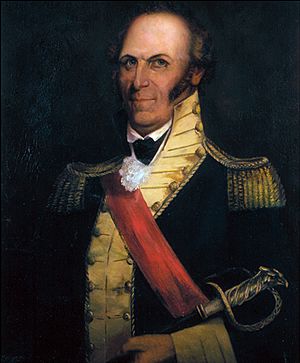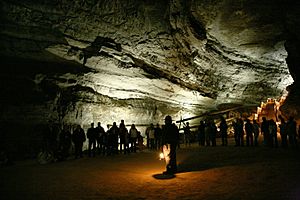Kentucky in the War of 1812 facts for kids
Kentucky played a huge role in the War of 1812, providing many soldiers and supplies. Because Kentucky didn't need to defend its own forts, most of its troops actively fought against the enemy. This meant Kentucky had more battle casualties than all other states combined.
Contents
Kentucky's Role in the War

As the war was about to begin, the governor of the Indiana Territory, William Henry Harrison (who later became a President of the United States), asked for military help from nearby Kentucky. On August 22, Harrison became a brigadier general in the Kentucky militia. He then went to gather troops to protect the Indiana government in Vincennes, Indiana.
Harrison had left the military in December 1811. But with help from Kentucky governor Charles Scott, he was able to get Kentuckians to defend Indiana. People in Ohio and Indiana didn't want to join because they heard there weren't enough supplies. So, most of Kentucky's militia during the war fought in what was then called the old Northwest Territory.
Kentucky Soldiers and Heroes
About 25,010 Kentuckians served in the war. This was about five out of every six men who were old enough to fight at that time! Kentucky sent 36 regiments, four battalions, and twelve independent companies to fight. This was an amazing achievement for a state with a small population.
| Counties named for fallen River Raisin officers | |
|---|---|
| Allen County | John Allen |
| Ballard County | Bland Ballard |
| Edmonson County | John Edmonson |
| Graves County | Benjamin Franklin Graves |
| Hart County | Nathaniel G. S. Hart |
| Hickman County | Paschal Hickman |
| McCracken County | Virgil McCracken |
| Meade County | James Meade |
| Simpson County | John Simpson |
John Allen was a former politician in Kentucky. On June 5, 1812, he became a colonel of the 1st Kentucky Rifle Regiment. These were the first militia troops raised by the state for the war. Allen was killed while leading his men at the Battle of the River Raisin in Michigan. He was buried in Frankfort Cemetery. Kentucky, Indiana, and Ohio all named counties after him.
Eight other Kentucky officers also died in this battle or the events that followed. Counties were named for them too. About 400 Kentuckians were killed at River Raisin. Eighty wounded prisoners were also killed by Native American allies after the British troops left. This terrible event led to the Kentuckians' rallying cry for the rest of the war: Remember the River Raisin!
Many Kentuckians also helped Andrew Jackson defeat the British soldiers. This happened at the Battle of New Orleans. The battle took place after the peace treaty had already been signed, but the soldiers didn't know it yet.
Where Kentucky Soldiers Fought
Kentucky militia members served in U.S. Army campaigns in many places:
- Indiana
- Illinois
- Ohio
- Michigan
- Ontario, Canada
- Louisiana
Isaac Shelby, Kentucky's 1st and 5th Governor, was a hero from the Revolutionary War. When he was in his 60s, he helped lead the Kentucky militia in the War of 1812. They helped free Fort Detroit from the British, and it was renamed Fort Shelby. Governor Shelby also joined General Harrison in chasing the British troops and the Native American leader Tecumseh into Canada. They defeated them and killed Tecumseh at the Battle of Moraviantown, which Americans called the Battle of the Thames.
Almost all the American soldiers at the Battle of Wild Cat Creek were from the Hopkinsville, Kentucky area. This battle was fought in northern Indiana.
Life in Kentucky During the War
Kentucky also helped supply the war effort. A main supply center was at Newport, Kentucky. This place, called Newport Barracks, later became a supply depot for other conflicts.
Saltpeter was mined a lot in Carter County and at the Great Saltpeter Cave in Rockcastle County. But the most famous mining was at Mammoth Cave. The saltpeter from Mammoth Cave was considered very good quality. About 570,000 pounds of it were produced during the war.
The war also changed Kentucky's economy. Because people couldn't trade with Britain during the war, new small factories started up. To help pay for the war, a tax was put on distilled spirits (alcoholic drinks). This tax lasted until 1817. The next time such a tax was used was during the American Civil War in 1862.
Kentucky's Future Leaders
The War of 1812 had a lasting impact on Kentucky. One big change was that the Shawnee people never again challenged white control of the state. Also, many of Kentucky's future leaders served in the war. Counting Isaac Shelby's second term as governor, which started right after the war began, six governors in a row were veterans of the war. Later governors Charles A. Wickliffe and John J. Crittenden also served as aides during the war.
Twenty-two of Kentucky's 120 counties are named after people who took part in the War of 1812. Nine of these counties are named after soldiers who died at the Battle of River Raisin.


